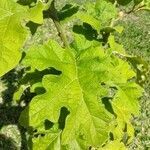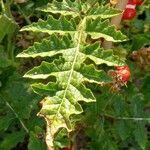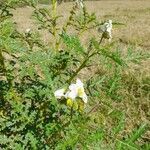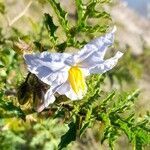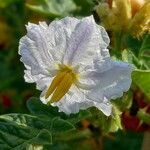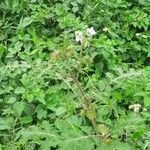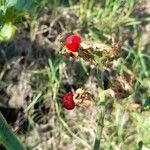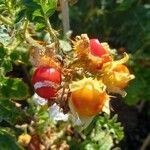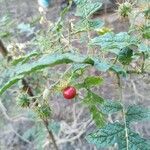Much-branched, shrubby very spiny perennials up to 1-5 m high, with extensive ramifying root systems. Stems green, robust, terete or angled, densely glandular pubescent, and beset with numerous strong, straight, bright orange-red patent spines up to 2 cm long, the bases of the spines glandular-pubescent. Leaves alternate, deeply pinnately lobed, up to 20 cm long, 10 cm broad on stout spiny petioles up to 5 cm long, lobes oblong, acute, deeply dentate, both surfaces green, stellate pubescent and sparsely glandular, spines mainly on both sides of midrib and veins, occasional on blade. Flowers in short lateral racemes, on glandular, spiny peduncles 4 cm long, calyx green, stellate glandular-pubescent, spiny, corolla stellate-pubescent outside, glabrous within, white, cream or bluish, up to 4-5 cm diameter. Fruits enclosed in enlarged, spiny calyces when young, bursting out at maturity, bright red, shiny berries 15 mm in diameter, many-seeded. Seeds yellowish-brown, lenticular, 2-5 mm diameter, testas pitted.
Annual or short-lived, perennial shrub, up to 1.5 m high, most parts with both glandular and stellate hairs. Prickles many, broad-based, straight, orange-red, up to 20 mm long. Leaves ovate-lanceolate, up to 200 x 100 mm, lobes oblong, dentate, prickles mainly on midrib and veins; petioles prickly, up to 50 mm long. Inflorescence a lateral raceme, few-12-flowered; peduncles up to 40 mm long. Calyx very prickly outside,6-12 mm long, lobes lanceolate, 4-7 mm long. Corolla rotate-stellate, glabrous inside, white, cream-coloured or ± blue. Fruit ovoid, up to 20 mm in diam., bright red, glabrous, shiny. Seeds many, lenticular, 2.5 mm in diam., pitted, yellow-brown. Flowering time all year.
Erect annual or short-lived perennial herb to 1.5 m high, green, pubescent with glandular and stellate hairs; prickles to 13 mm long, abundant on most parts. Leaves ovate-lanceolate; lamina 5–14 cm long, 4–10 cm wide, concolorous, lobed; lower lobes often forming leaflets; petiole to 4 cm long. Inflorescence up to 12-flowered; peduncle to 45 mm long; rachis up to 15 cm long; pedicels 10–15 mm long, elongated slightly in fruit. Calyx 6–12 mm long, enlarged in fruit; lobes lanceolate, 4–7 mm long. Corolla stellate, 35–50 mm diam., white or pale blue. Anthers 8–10 mm long. Berry globular, 15–20 mm diam., bright red. Seeds 2–2.5 mm diam., pale buff.
Much like no 6 [Solanum rostratum Dunal]; stellate-hairy in the infl and also glandular-villous; lvs to 2 dm, stellate-hairy, deeply and irregularly pinnatifid, the segments coarsely toothed or shallowly lobed; cor pale violet or blue, 3 cm wide; anthers yellow, equal; 2n=24. Native of S. Amer., established as a weed in s. U.S., and often adventive in waste places along the coast in our range. S. citrullifolium A. Braun, a related sp. mainly of Mex. and Tex., has been reported, perhaps mistakenly, from our range. It has unequal anthers, one of them much the longer, outcurved, and violet.
Perennial herb, dwarf shrub or shrub, up to 1.5 m high; densely spiny; sticky glandular-hairy. Spines straight; orange-red or reddish brown. Leaves with blade up to 200 mm long, deeply pinnately lobed, lobes further lobed, toothed, both surfaces stellate-pubescent and sparsely glandular. Flowers: in a short, lateral raceme; corolla white, cream-coloured or bluish; Jan.-Dec. Fruit a bright red berry, enclosed in enlarged, spiny calyx, ± 15 mm in diameter.
A herb or small shrub. It grows 1-1.3 m high. The stems are 1-1.5 cm across. It has spines 1-1.3 mm long. The leaves are simple alternate. They are 20 cm long by 12 cm wide. The leaves have lobes. There are teeth along the edges. There are spines on the veins. The flowers are at the ends of branches. They occur singly. The fruit is round and 2 cm across. It is in a spiny case. This opens to reveal the red fruit.
Spiny shrub, up to 1.5 m high. Spines straight. Leaves deeply pinnately lobed, stellate-pubescent and sparsely glandular. Inflorescence a short lateral raceme. Fruits enclosed in enlarged spiny calyces, red. Flowers white, cream or bluish.
Spinescent shrub. Spines long, straight. Leaves ovate, pinnatifid, lobes acute, glandular pubescent intermixed with stellate hairs. Cymes axillary, many-flowered. Corolla 25 mm in diameter. Berries red.
